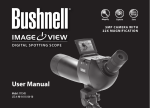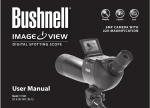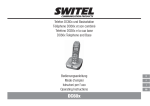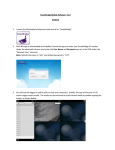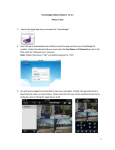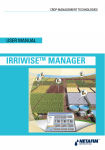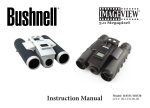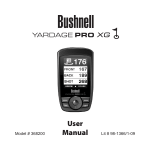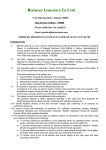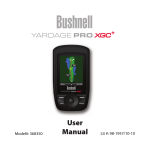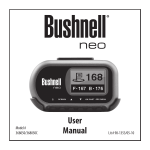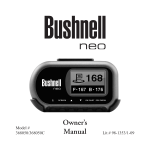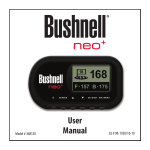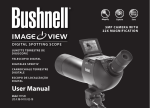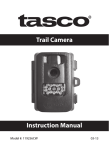Download User Manual
Transcript
Magnify Capture Save 5M P C a m e r a w i t h 22x m ag n i f i c at i o n D i g i ta l s p ot t i n g s co p e User Manual Model: 111545 Lit. #: 98-1411 / 10-09 Parts and Controls Guide (G) LCD Display (K) Remote Jack (L) USB Port (D) OK Button (M) Card Slot (E) SNAP Button (C) Up/Down Arrow Keys (A) ON/OFF (B) MODE Button Button (O) Focus Knob 2 (N) Zoom Setting (H) Power LED (J) Diopter Adjustment (F) Eyepiece/Camera Select Slider (I) Battery Compartment QUICK START GUIDE 1) To use the ImageView as a standard spotting scope, attach it to a tripod (a small one is included), set the slider (F) to the “Eyepiece” position, and look through the eyepiece (the rubber eyecup may be rolled down if you wear glasses). The eyepiece diopter adjustment (J) index dot should be set to the “0” position. Aim the scope at your subject and adjust the focus knob (O) until it appears sharp. The eyepiece zoom (N) may be set to any magnification desired from 15x to 45x power. Readjust the focus if you start at low power and zoom up to a higher setting. 2) To setup the digital camera, insert two AA batteries (not included) into the compartment (I), noting the polarity marks. Plug the included remote shutter cable into the jack (K) to prevent jarring the scope when taking photos. The ImageView scope has internal memory that will hold about 15 photos (at the default 5MP resolution). However, the internal memory contents may be lost if the batteries are removed or get very weak during storage, and you may prefer to use an SD card for its much greater storage capacity. Insert your SD card (face up, notch on right) in the slot (M). The card will click into place. Push the card in slightly to remove. You may use SD cards (avoid using MMC cards) up to 4 GB capacity. Raise the LCD display (G), and press the ON/OFF button (A) briefly-the Power LED (H) will light. If the SD card you inserted was previously used in other devices, format it before taking photos. Note that this will erase all files-on your card (or the internal memory if no card is present) -make sure you have backed up any files you wanted to keep. Press the MODE button (B) to enter the Capture menu (Fig. 1), then press the SNAP button (E) to enter the Setup menu (Fig. 2). “Format” is the first option-press the OK button (D), then the Down arrow key (C) to select “Execute”, and press OK. Press the MODE button to exit all menus. 3) When you are ready to take a photo, switch the slider (F) to “Camera”. Note: your photos will be black if the slider is left in the Eyepiece position. The internal camera provides a fixed magnification of about 22x-this corresponds to what you see through the eyepiece with the zoom ring set to the green dot position (lined up with the red index dot). Adjust the focus knob if necessary, so the subject appears sharp on the LCD. Press the button on the remote shutter cable to take the photo. It is also possible to shoot video movies (VGA, 20 fps) with the ImageView scope. Press and hold the SNAP button for 2-3 seconds, then release. A movie film icon appears in the display at top left. Press the remote shutter button to start recording. A counter at the bottom of the display shows elapsed time. Hold the SNAP button down for a few seconds again to return to still photo mode. The camera will automatically turn itself off after three minutes of inactivity (this can be changed with the “Auto Off” options in the Setup menu-see the online full user’s manual for more information). 3 QUICK START GUIDE Tip: it may be helpful to use the 4x digital zoom feature to check focus on small details. Press the Up arrow key (C) repeatedly -the display will show the zoom setting, from “1.1x” up to “4.0x” Photos may be taken using the digital zoom, but you will get the best possible quality by zooming back fully (down to “1.0x”) by pressing the Down arrow key before taking a photo. 4) For greater convenience, you can avoid the need to stop and check focus on the LCD every time you want to switch over to use the camera function and take a photo by setting up the eyepiece diopter adjustment (J) to compensate for any difference between the LCD and your vision. To do this, start with the slider in the Camera position and use the focus knob (O) to get a sharp image on the LCD of any object with fine detail. Next, switch the slider to the Eyepiece position, and set the zoom ring (N) to the “green dot” position to match the camera’s magnification. Look through the scope’s eyepiece and rotate the diopter adjustment (do not adjust the main focus knob) until the image appears sharp to your eye. Note the setting of the diopter index mark (dot). You will now be free to snap a quick picture anytime you see something interesting through the scope. Simply adjust the focus knob until the image through the eyepiece is sharp, switch the slider over to “Camera”, and take the photo-it’s not even necessary to raise the LCD. 5) To review your photos, press the OK button to enter Play mode. You will see the most recent photo. To step through previous photos one at a time, press the Down arrow key. The first frame of any videos will be displayed, but it is not possible to playback videos on the LCD (see the download directions below). To delete one or more photos/videos, press MODE to enter the Play menu (Fig. 3). The first item on the menu, “Delete”, is already highlighted. Press the OK button. “Single” is highlighted, meaning you will delete only the currently displayed photo/video. Press the Down arrow key to select “All” if you wish to delete every photo and video stored on the card or internal memory. Press OK, then press the Down arrow key to select “Execute”. Press OK to delete the file(s). Press MODE again and repeat the process if you see another photo you want to delete. When you have finished reviewing or deleting photos, press OK to return to the normal preview (live image) display. 6) To download your photos/videos to a PC or Mac, connect the supplied cable to the ImageView scope’s USB port (L), then directly to a main USB port on your computer-do not use front panel/keyboard USB ports or unpowered “hubs”. The LCD will power on, then go black, and the ImageView scope will be recognized as a standard “USB Mass Storage” device (this may take several seconds the first time you connect). 4 QUICK START GUIDE With Windows XP or later, you can simply use the options in the pop-up window to copy, view, or print your photos (right). On all Windows OS, the ImageView scope will appear as a “Removable Disk” under the “My Computer” list (on Macs, an icon will appear on your desktop). The ImageView’s photo files are named “PICT0001. JPG” etc, and are located in the “DCIM” folder on this “Removable Disk”. Video file names will end with “.AVI”. You may copy the photos/videos to your hard drive as you would any file-just copy/paste or drag the file names or icons to your drive or desktop. After the photos are copied to your hard drive, you can disconnect the camera. (On Mac computers, drag the “disk” that appeared on your desktop when the camera was connected into your Trash to “eject” it before disconnecting.) The .jpg standard files from the ImageView scope may be viewed and edited with any photo software you choose to use. The .avi video files may be viewed with Windows Media Player (version 7 or later) or the free QuickTime player (download available at www.apple.com) as well as many other video playback programs that may have been supplied with your computer, or are available free online. NOTE: If you are not using an SD card in the ImageView scope, be sure to download all files from its internal memory before changing batteries and before storing the camera for a long period. If you use an SD card, photos may also be downloaded by removing the card and using any USB card reader with an SD slot. Your ImageView spotting scope is already set for high resolution and quality right out of the box, and it is not necessary to change any of the settings to get good results. However, many features and options are provided to enhance your enjoyment of the camera. For more information about them, please refer to the sections of this manual describing the Options and Settings available in the Capture, Setup, and Play menus. 5 BASIC SETUP Loading Batteries Slide the battery cover (I) open in the direction indicated by the arrow, then swing it out to the right. Insert 2 AA Alkaline or Lithium batteries into the compartment in the direction indicated inside, then replace the cover, sliding it back into place until it clicks. Note: Rechargeable NiMh type batteries may also be used, but some may not deliver adequate current to power the camera and display. Inserting An SD Card The camera can store from about 11 (at 5MP resolution and “Best” quality) up to over 100 photos in the internal memory, depending on resolution and quality settings. To expand the available storage, you may add an optional SD (Secure Digital) memory card, with 4GB or lower capacity. The camera will not function if a card with over 4GB capacity is inserted. Do not use “MMC” cards, which look similar to SD cards. The card is inserted into the slot (M) on the left side of the scope (pull out the rubber cover flap-please refer to the “Parts & Controls Guide” page), label side up with the “notched” corner on the right as indicated by the card icon below the slot. Note: be sure the power is turned off before inserting or removing cards to prevent possible loss of files or damage to the card. A new card will not require formatting, but a card that has been previously used in other devices (cameras, mp3 players, etc) should be formatted by the ImageView scope before you start taking photos (see the “Setup Menu” section for details). Note that formatting will erase all files previously stored on the card, so be sure they have been downloaded and saved on your computer first if you wish to keep them. Setting the Date and Time/Date Stamp Feature You may want to go into the main options menu and set the date and time before beginning to take photos, so that it will be correct if you want to imprint it on your photos (if so, you must activate that option in the Capture menu, as the default is “No (date or time) Stamp” . To set the date and time: 6 BASIC SETUP 1. 2. 3. 4. 5. 6. Raise the LCD display (G) and press the ON/OFF (A) button. Press MODE (B). Press and release the SNAP button (E) to enter the Setup Menu. Press the Up arrow key (D) once to highlight “Date & Time”, and press the OK button (D). Now set the Date, Month, Year, Hour (24 hr format), Minute and Second, using the Up/Down arrow keys to make changes, and pressing the SNAP button to lock in the setting and move to the next field. (Optional) Once you finish setting the date & time, press the OK button. Press and release the SNAP button to switch from the Setup menu to the Capture menu. Press the Up arrow key once to highlight “Date Stamp”, press OK, then highlight your preference using the Up/Down keys: Date Only, Time Only, Date & Time, or leave it on the default “No stamp” (nothing will be stamped on your photos). Press OK to confirm your setting, then press the Mode key twice to exit the Capture menu and return to the “live” preview display. Auto Off (Power Save) By default, the SyncFocus will automatically turn off if no buttons or controls have been pressed for three minutes. This helps save power and extend battery life when the camera is accidently left on. However, when you are first learning to use the camera you may want power to remain on (until you press ON/OFF) as you get familiar with the features and controls. To do this, enter the Setup menu as described above in Step 2 under “Setting the Date...”, highlight “Auto Off”, press OK, and select “Off”. Press OK again, then exit the menu by pressing Mode. Menu Display Language Options (English, French, Spanish, German, Italian, Portuguese, Chinese 1 or 2) The Setup menu also has an option to select your preferred language for all menu screens. Once in the Setup menu, highlight “Language”, press OK, select your preference with the Up/Down arrow keys, press OK, press Mode. 7 BASIC SETUP Setting the Diopter Adjustment Before you begin taking photos, a simple, one-time adjustment should be made to ensure that you can get sharp photos of any subject once you have it focused as you view it normally through the scope’s eyepiece. This process will compensate for any variations in the eyesight or vision of the individual user: 1. 2. 3. 8 Leave the rubber eyecup in its “up” position if you are not wearing glasses, or roll it down if you are. Raise the LCD display and move the slide lever (F) to the “Camera” position. Point the scope at a distant object (preferably one containing fine detail such as a tree or sign), and adjust the focus knob (O) until it appears as sharp as possible on the display. Move the slide lever over to the “Eyepiece” position and set the zoom ring to the green dot (just left of 15x)-this is roughly the same magnification as what the camera captures. Look through the eyepiece. DO NOT READJUST THE FOCUS KNOB. If the subject does not appear sharp to your eye, rotate the rubber diopter adjustment ring (J) at the base of the eyepiece. This compensates for any difference in between your vision and the correct focus for the camera. Once set, note the position of the dot on the diopter adjustment ring relative to the “+ /0 / -” scale on the scope. With the diopter adjustment set to this position, you should be able to get sharp photos/videos of a subject at any distance by simply adjusting the main focus knob while you look through the eyepiece, then switching over to “Camera”. There is no need to re-adjust the diopter adjustment, unless you share the ImageView scope with another user, or if your eyes become tired over a long period of use. For important shots, you may want to take the precaution of double checking focus on the LCD display too. If you are having trouble fine tuning focus when viewing the LCD, try pressing the Up arrow key to zoom in (up to 4x digital zoom is available), then focus. Be sure to use the Down key to zoom back to 1.0x (no digital zoom, optical magnification only) after you adjust the focus if you do not want to use digital zoom when you take the photo. TAKING STILL PHOTOS Taking Still Photos After completing the basic setup as described in the previous pages, you are ready to take a photo: 1. 2. 3. 4. With the ImageView scope securely mounted on a tripod, raise the LCD display (A) and briefly press and release the ON/OFF button-the power LED (H) lights and the startup screen is displayed, followed by the live image from the camera lens. The display also shows the battery condition, number of photos remaining, and the current resolution/quality settings. Please refer to “LCD Display:Menus and Icons” for more details. The ImageView scope will default to high resolution and quality settings, as well as “everything on automatic” when it is turned on for the first time, so you’re ready to take photos under most conditions with no need to change anything. If you would like to explore the various available options, see the manual section titled “The Capture and Setup Menu-Options and Settings” for directions regarding how to select and change settings such as resolution, image quality and exposure. When the Eyepiece/Camera select slider is in the “Eyepiece” position, the image formed by the front (objective) lens is directed to the eyepiece rather than the digital camera sensor, so the LCD display will not let you see the “live image”. The scope’s zoom eyepiece provides optical zoom from 15x to 45x magnification, while the camera’s magnification is fixed at approximately 22x. If you want to preview the framing of your subject as you are looking through the eyepiece prior to taking a photo, rotate the zoom ring so that the green dot is opposite the red index dot (this sets the eyepiece to about 22x magnification). When you are ready to take a photo, be sure to move the select slider over to “Camera”otherwise your photo will be partially or entirely black. And you will then be able to use the LCD display for preview and review as you take photos. Although the SNAP button on the scope may be used to take photos, it is highly recommended that you plug the supplied remote shutter cable into the remote jack (K) to obtain the steadiest results (press the 9 TAKING STILL PHOTOS 5. 6. 7. button on the remote to take a photo). The display will “freeze” briefly immediately after a photo is takenthis is normal while the image is being stored in the internal or card memory. The “remaining photos” counter in the lower right corner of the display will drop by one number after each photo (or two, depending on your subject and settings) is taken. Once it reaches “00”, and the display indicates “MEMORY FULL” when SNAP is pressed, you are out of memory (storage space) and will need to download the photos you have taken so they can be deleted to make room in the memory for new photos, or you may remove the filled up card and install another SD card if you are on a trip away from your computer. A digital zoom feature is available. Press the Up arrow key to zoom in (you will see the result on the LCD, and the digital zoom indicator increases in 0.1x increments up to 4.0x ). Press the Down arrow key to zoom back out (the zoom indicator decrements down). To turn off all digital zoom (go back to the 22x optical magnification only) keep pressing the Down key until the zoom indicator goes back down all the way to “1.0x” and disappears. To review a photo after you take it, press the OK button. To see previous photos, press the Down arrow key-each press takes you back one photo, and pressing the Up arrow key moves forward to more recent photos. Press the OK button again to return to the live preview. See the section “The Play MenuOptions and Settings” for directions covering deleting photos, formatting internal or card memory, and protecting important photos. NOTE: Use care during handling to avoid touching the exposed lenses of the ImageView spotting scope to prevent degrading the image quality. Clean the lenses only with camera lens cleaning tissue or microfiber cloth, after removing loose dust or dirt with a blower brush or “canned air”. Camera lens cleaning fluid may be used if necessary (lightly moisten the lens tissue, do not apply directly to the lens), avoid the use of other liquids of any type. 10 Shooting Videos Shooting Videos (Setting/Using Video Mode) To switch from still photo to video mode, hold the SNAP button down for 2-3 seconds, until a beep is heard. The video mode icon (a frame of movie film) will appear at the top left corner of the LCD. You are now in Video Mode. Press the SNAP button on the remote cable or scope twice to start recording a new video clip, and press it once again to stop recording. The recording time is limited only by the amount of internal or card memory currently available. You may record a single long video until you run out of memory or multiple shorter videos by stopping and starting recording whenever you wish by pressing SNAP. The counter at the bottom of the display shows the time elapsed since the recording was started. Videos are recorded as “.avi” format files, with VGA resolution (640x480 pixels per frame, 20 fps rate). Note that the Size and Quality settings in the Capture menu do not affect videos, only still photos. Press the OK button if you wish to check a video after you shoot it. Press the SNAP button to begin playback, press it again to pause playback (the display will indicate “AVI PAUSE”). During playback, the counter at the top of the LCD displays time elapsed since the start of the video clip. Press the Down arrow key to review previous video or still photo files. When you are ready to return to the live preview display to shoot more videos (or stills), press the OK button. 11 LCD Display: Menus and Icons Display Icons (Preview Screen) Still Photo (shown) or Video Movie Mode Resolution and Quality Settings Capture Menu Photos Remaining Fig. 2 12 Fig. 1 Battery Level Setup Menu Fig. 3 Play Menu Capture and Setup Menu-Options and Settings The Capture and Setup Menu-Options and Settings As mentioned earlier in this manual, your ImageView spotting scope is already set for high resolution and quality right out of the box. Exposure, white balance, and other variables are set automatically. This means that you will get good results for most subjects and lighting without the need to go into the menu to change any settings. However, we recommend that you become familiar with the available options so that you can improve your photos if, for example, you decide they are coming out too dark (common for snow scenes with most cameras), or too green (under some fluorescent lights). Press the MODE button to enter the Capture menu. Use the Up/Down arrow keys to highlight an option within the menu, then press OK if you wish to change the settings for that option. Use the Up/Down keys to select the setting you want, then press OK to confirm this setting. Here are all the options and settings available in the “Capture” menu, along with descriptions of what they do: OPTION SETTINGS DESCRIPTION Size (Resolution) 8M*, 5M, 3M, 2M, 1.3M, VGA Sets the desired still photo resolution in Megapixels. Higher resolution settings produce sharper/larger prints but require more storage space in internal or card memory. Use lower settings to store more in memory, or for email, PC viewing only, etc. *8MP via software interpolation. Actual sensor resolution is 5MP. Note: Default settings are indicated in bold 13 Capture and Setup Menu-Options and Settings 14 OPTION SETTINGS DESCRIPTION Quality Fine, Standard ,Economy Sets the amount of file compression, which affects the quality of the photo and the size of the file it creates. This can be used independently of Image Size to help store more photos in exchange for slightly reduced quality. “Best” produces the highest quality, but also generates larger files that fill available memory sooner (fewer photos possible). EV -2.0 ~ +2.0 (Default= 0 EV) Provides manual under/over exposure adjustment in 0.5 EV steps. Minus values produce darker photos, plus values lighter. When a subject is mostly bright (snow scene), you may need to add some “+” EV to avoid underexposure. White Balance Auto, Daylight, Cloudy, Tungsten, Fluorescent Sets the reference for neutral white, so that colors are reproduced correctly. If “Auto” does not provide good results, try the setting that matches the light source. ISO Auto, 100, 200 Sets the sensor’s sensitivity to light. “Auto” will automatically select ISO 100 for bright conditions, and ISO 200 when the light is dimmer-or you can select either yourself, and it will stay on that setting until you change it. Color Standard, Vivid, Sepia, Monochrome Selects normal color reproduction (Standard), or any of 3 color effects. Vivid=more intense colors, Sepia=brown toned, Monochrome=black and white photos Capture and Setup Menu-Options and Settings OPTION SETTINGS DESCRIPTION Saturation High, Normal, Low Affects how deep colors appear. Setting this to “High” can help counteract drab color reproduction on overcast days, and “Low” can be useful for a more natural appearance of colors under harsh, bright lighting. Sharpness High, Normal, Low Sets the amount of sharpening applied by the internal processor. You may want to select “Low” if you prefer to add sharpening later using photo software on your PC. Date Stamp No stamp, Date Only, Time Only, Date & Time To prevent imprinting the date and time, leave this set to the default “No stamp”. To imprint the date and/or time on your photos as you take them, select one of the other 3 options according to your preference. For details on how to set the current date and time, see the next section covering the Setup Menu. 15 Capture and Setup Menu-Options and Settings The Setup Menu-Options and Settings The Setup menu contains a group of options providing “system settings” that you can use to set your operational preferences, rather than settings that affect the appearance of your photos as the options in the Capture menu do. Most of these will therefore be a one time, “set and forget” option. To access the Setup menu, enter the Capture menu (if you are not already in it) by pressing MODE, then press the SNAP button briefly and you will see the Setup menu on the display, with these options/settings: 16 OPTION SETTINGS DESCRIPTION Format Cancel, Execute Select “Execute” and press OK to delete the entire contents of internal or card memory. When an SD card is inserted that has been used previously in other devices, formatting it before starting to take photos is recommended (be sure any files you want to keep have been downloaded and backed up first). Beep On, Off Allows the user to turn off the confirmation beep that sounds by default when pressing the SNAP button to take a photo, and when pressing the arrow keys and OK buttons to navigate the options/settings menus. Useful when hunting or during legal survelliance to avoid detection. Language English, Spanish, French, German, Italian Selects preferred language for all menu display screens Capture and Setup Menu-Options and Settings OPTION SETTINGS DESCRIPTION Auto Off 1 Min., 3 Min., 5 Min., Off Sets the interval after the last action (pressing any button) before the camera turns off to conserve battery power. Select “Off” to prevent auto shutoff altogether. Default setting is power off after three minutes elapses. Sys. Reset Cancel, Execute Select “Execute” and press OK to restore all settings for all options (in all menus) to their original factory default settings. Light Freq. 50 Hz, 60 Hz Set to the AC line frequency for your country. Affects primarily videos shot under fluorescent lighting. Date & Time (setting) Year, Month, Day, Hour, Minute, Second Press OK, use the Up/Down keys to change the year, then press SNAP to move to the next field (month), use Up/Down keys to change it...repeat until all of the date and time fields have been set, then press OK again to lock in this Date/Tiime setting. 17 PLAY Menu-Options and Settings The Play Menu-Options and Settings The Play menu contains a group of options related to reviewing your captured photos after you take them. To enter Play mode, press OK. Use the Up/Down buttons to step through your photos. Once you are already in Play mode, press MODE to enter (or exit the Play menu). As described previously, use the Up/Down keys to select the setting you want, then press OK to confirm this setting. The Play menu includes these options/ settings: 18 OPTION SETTINGS DESCRIPTION Delete Single, All >(Cancel, Execute) Select “Single” to delete only the currently displayed photo, or select “All” to delete all photos saved in the internal or card memory (be sure you have downloaded any that you wanted to keep first). After pressing OK to confirm, you will have the choice to “Cancel” (if you change your mind or select the wrong option) or “Execute”-select this and press OK to delete the single photo or all photos, depending on which selection you made in the first step. Note: photos which have been “protected” cannot be deleted (see the Play Menu option “Protect”). Copy to Card (Cancel, Execute) Copies files from internal memory to card. Select “Excecute” and press OK to copy. This option is only available if an SD card has been inserted. PLAY Menu-Options and Settings OPTION SETTINGS DESCRIPTION Slide Show 3 sec, 5 sec, 10 sec This option lets you see an automatic “show” of all the photos stored in memory (beginning with the oldest). The settings let you choose how long each photo will be seen on the display before changing to the next one. Select one of the three intervals and press OK to start the “slide show”. DPOF (Digital Print Order Format) Single, All This feature lets you “mark” photos stored on your SD card for printing by a photo lab or home printer that supports DPOFunmarked photos will be skipped and not printed. Select “Single” and press OK to indicate you want a print of the currently displayed photo, or select “All” if you want all of your photos to be printed. Protect Single, All Lets you protect individual or all photos from being accidently deleted. Select “Single” , then press OK to protect the currently displayed photo, select “All” and press OK to protect all stored photos. Select “Single” or “All” and press OK a second time to “unprotect” one or all photos if you later want to delete them. Rotation Cancel, 90⁰, 180⁰, 270⁰ Set to the AC line frequency for your country. Affects primarily videos shot under fluorescent lighting. 19 FCC Compliance Statement: TWO-Year LIMITED WARRANTY Your Bushnell® product is warranted to be free of defects in materials and workmanship for two years after the date of purchase. In the event of a defect under this warranty, we will, at our option, repair or replace the product, provided that you return the product postage prepaid. This warranty does not cover damages caused by misuse, improper handling, installation, or maintenance provided by someone other than a Bushnell Authorized Service Department. Any return made under this warranty must be accompanied by the items listed below: 1) A check/money order in the amount of $10.00 to cover the cost of postage and handling 2) Name and address for product return 3) An explanation of the defect 4) Proof of Date Purchased 5) Product should be well packed in a sturdy outside shipping carton, to prevent damage in transit, with return postage prepaid to the address listed below: IN U.S.A. Send To: Bushnell Outdoor Products Attn.: Repairs 8500 Marshall Drive Lenexa, Kansas 66214 IN CANADA Send To: Bushnell Outdoor Products Attn.: Repairs 25A East Pearce Street, Unit 1 Richmond Hill, Ontario L4B 2M9 For products purchased outside the United States or Canada please contact your local dealer for applicable warranty information. In Europe you may also contact Bushnell at: Bushnell Germany GmbH European Service Centre Mathias-Brüggen-Str. 80 D-50827 Köln GERMANY Tel: +49 221 995568-0 Fax: +49 221 995568-20 This warranty gives you specific legal rights. You may have other rights which vary from country to country. ©2009 Bushnell Outdoor Products Windows is a registered trademark of Microsoft Corporation in the United States and other countries. Mac and Mac OS are trademarks of Apple Inc., registered in the U.S. and other countries. 20 This equipment has been tested and found to comply with the limits for a Class B digital device, pursuant to part 15 of the FCC Rules. These limits are designed to provide reasonable protection against harmful interference in a residential installation. Operation is subject to the following two conditions: (1) This device may not cause harmful interference, and (2) this device must accept any interference received, including interference that may cause undesired operation. This equipment generates, uses and can radiate radio frequency energy and, if not installed and used in accordance with the instructions, may cause harmful interference to radio communications. However, there is no guarantee that interference will not occur in a particular installation. If this equipment does cause harmful interference to radio or television reception, which can be determined by turning the equipment off and on, the user is encouraged to try to correct the interference by one or more of the following measures: · Reorient or relocate the receiving antenna. · Increase the separation between the equipment and receiver. · Connect the equipment into an outlet on a circuit different from that to which the receiver is connected. · Consult the dealer or an experienced radio/TV technician for help. The device does not contain any user-serviceable parts. Repairs should only be made by an Authorized Bushnell repair center. Unauthorized repairs or modifications could result in permanent damage to the equipment, and will void your warranty and your authority to operate this device under Part 15 regulations. The shielded interface cable which is provided must be used with the equipment in order to comply with the limits for a digital device pursuant to Subpart B of Part 15 of FCC Rules. Specifications and designs are subject to change without any notice or obligation on the part of the manufacturer. INNOVATION THAT THRIVES OUTSIDE For further questions or additional information please contact: Bushnell Outdoor Products 9200 Cody, Overland Park, Kansas 66214 (800) 423-3537 • www.bushnell.com ©2009 Bushnell Outdoor Products





















